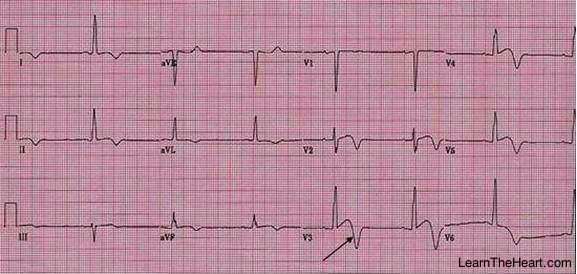Two for the Price of One - ECG Case #2

Here is a nifty ECG case with two unrelated — but interesting — findings on one ECG tracing. One, a life-threatening diagnosis, and the other, a rare incidental finding leading to heart failure in this patient.
An 81-year-old, previously healthy male presents with recurrent syncope. He has also noted increasing dyspnea and lower extremity edema for the past year; it has been mild, and thus he never sought medical attention. Here is his ECG:

ECG Finding #1 - Life Threatening
The rhythm is sinus (upright P waves in lead II), but with third-degree atrioventricular (AV) block, also known as complete heart block. Look at the rhythm strip at the bottom in V1. You can march out the P waves and see they are not at the same rate as the QRS complexes.
Here is what you should know about third-degree AV block:
- The P waves are not able to conduct at all through the AV node to the ventricles.
- P waves (atrial depolarization) are at a different rate than the QRS complexes (ventricular depolarization). This is called "AV dissociation."
- The QRS rate is usually quite slow and originates at the AV junction (junctional escape, narrow QRS, rate 40-60) or in the ventricles (ventricular escape, wide QRS, rate 20-40).
- Symptoms of bradycardia are usually present, including syncope, weakness, dyspnea and heart failure.
- A permanent pacemaker (PPM) is the treatment of choice.
Here is another example of third-degree AV block:

Here are even more examples:
- Third-Degree AV Block (Example 1)
- Third-Degree AV Block (Example 2)
- Third-Degree AV Block (Example 3)
- Third-Degree AV Block (Example 4)
- Third-Degree AV Block (Example 5)
- Third-Degree AV Block with Ventricular Pacing
ECG Finding #2 - Rare Cause of Heart Failure
This patient was found to have "Apical Hypertrophic Cardiomyopathy" — also known as "Yamaguchi syndrome" — a variant of hypertrophic cardiomyopathy. This can lead to slowly progressing diastolic congestive heart failure.
The ECG findings of apical hypertrophic cardiomyopathy include giant T-wave inversions in the precordial leads. Here is another ECG example of apical hypertrophic cardiomyopathy, with the arrow pointing at the giant T-wave inversions:

Some points to know about apical hypertrophic cardiomyopathy:
- Treat with verapamil or diltiazem (dihydropyridine calcium channel blockers) or beta-blockers to lower heart rate, allowing for more diastolic filling time.
- There are no data to support disopyramide in this disease, as there is in typical hypertrophic obstructive cardiomyopathy (HOCM).
- Surgical apical myomectomy is reserved for refractory cases.
I have only had one patient undergo apical myomectomy. That patient developed severe systolic dysfunction and severe mitral valve regurgitation requiring surgical repair about 2 years later!
Editor’s note: This Blog was originally published on learntheheart.com.
